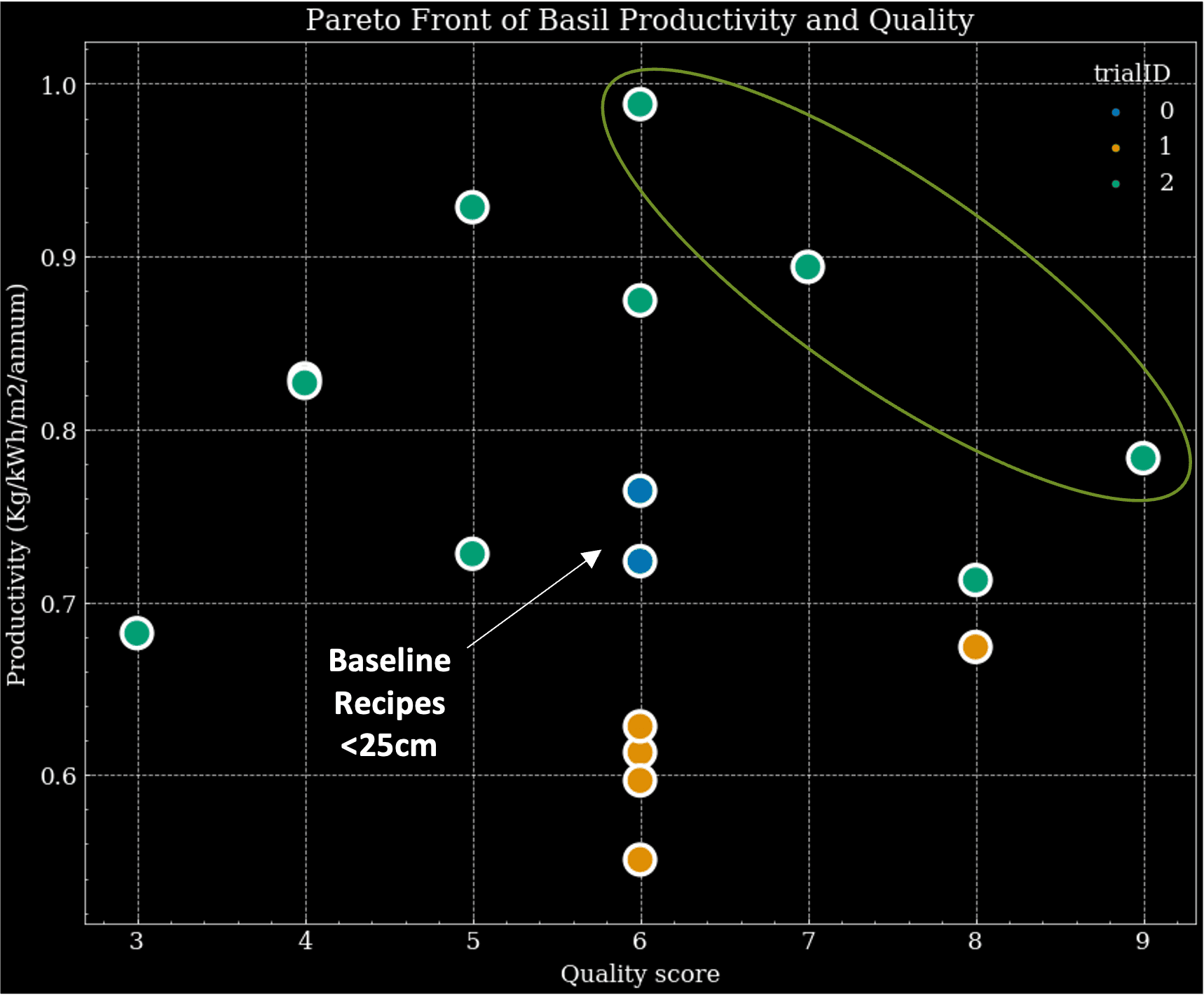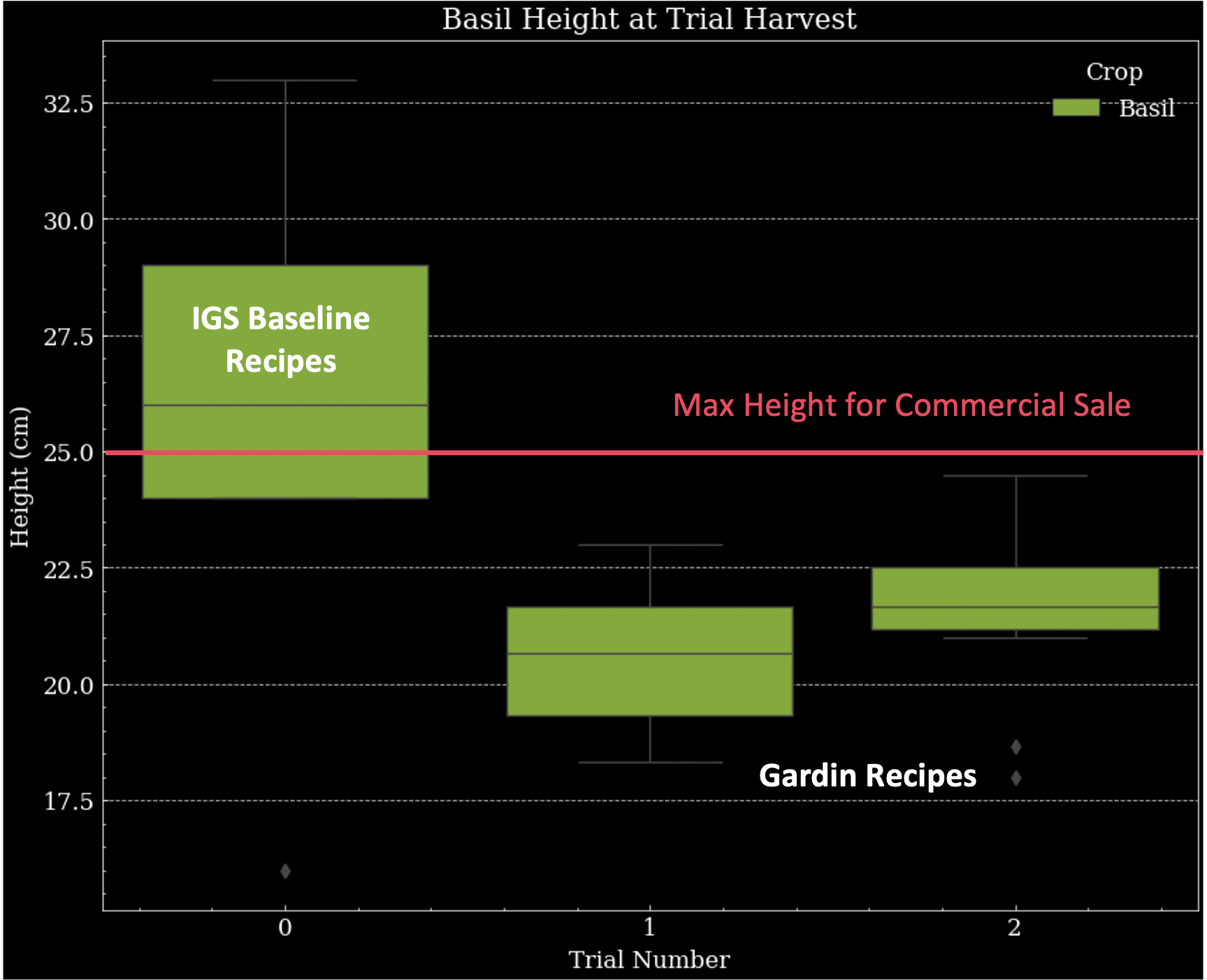
- Industry: Vertical Farm Manufacturer
- Region: Europe
IGS Leverages Gardin Pulse to Perfect Light Recipes and Unlock Higher Yields
- 40%
yield increase - Optimised
light recipes - Slashed
development time - Increased
biomass per kWh
Summary
- 30-40% yield increase on basil, lettuce and pak choi.
- Higher energy efficiency with more biomass per kWh.
- Real-time crop feedback turned light recipe development into a faster process.
"For the first time, Gardin's advanced sensors have enabled us to remotely explore plant activity in an industrial setting. This breakthrough has been a significant milestone in our quest to perfect recipe development and crucial for creating the optimal plant environment."
Csaba Hornyik - Head of Science, IGS

Fig. 1 Yield of three different crops (basil, lettuce, pakchoi), showing an increase from baseline to optimum.
IGS operates one of Europe's most advanced vertical farming systems. Although the growing environment is fully automated, understanding how plants truly respond to light has been a challenge. In 2022, IGS partnered with Gardin to bring real-time plant feedback into their precision farming model.
Gardin's photosynthesis data helped IGS optimise lighting strategies across basil, lettuce and pak choi, delivering yield increases of up to 40% and significantly improving energy efficiency. Optimisation cycles that previously took months were completed in just weeks. The results demonstrated how plant-driven control can unlock new gains in both productivity and profitability for vertical farming.
Background
Intelligent Growth Solutions (IGS) is a Scottish agri-tech company developing modular growth towers for vertical farming. Their automated systems allow for precise control over light, climate, irrigation, and nutrition. Despite total environmental control, one critical piece remains hidden: how the plant is truly responding to its conditions.
In vertical farms, where crops are physically inaccessible and human entry disrupts the microclimate and introduces biosecurity risks, traditional methods of observation are infeasible. Understanding the plant's physiological response — particularly how climate variables influence photosynthesis — requires real-time, remote sensing and direct plant feedback. Without it, recipe optimisation is slow and doesn't represent production growing environments.
In 2022, IGS partnered with Gardin to bridge that gap and enable plants to communicate directly with operators. In doing so, the project aimed to significantly improve yield and energy efficiency by using photosynthetic feedback to optimise LED 4-channel lighting strategies.
The Challenge
Traditional methods of measuring crop performance rely on delayed indicators such as fresh weight at harvest, making recipe optimisation a slow, reactive process. IGS recognised that even with well-engineered lighting schedules, environmental uniformity is hard to guarantee across large-scale towers. Microclimates, subtle variations in germination density, and plant-to-plant variability can all lead to inconsistent performance.
Additionally, light-use efficiency (i.e., how much biomass a plant produces per unit of energy used) is critical in vertical farming where energy costs are substantial. IGS sought a method to close the loop between the amount and quality of light that the plants are given and what is used productively for plant growth.
The Role of Gardin
Gardin's chlorophyll fluorescence sensor captures real-time measurements of photosynthetic efficiency — a physiological metric that directly reflects how well plants are converting light into energy. The sensor passively scans the canopy and provides non-destructive, quantitative data on photosynthetic activity under actual growing conditions.
The initial phase of the project involved growing over 50 plant batches under varying lighting intensities, while keeping other climate variables constant. Fertigation strategies and seeding densities were also varied to test the sensor's robustness in real-world conditions.
The results were compelling: photosynthetic efficiency measured by Gardin consistently tracked with crop fresh weight (kg/m²/year) and light-use productivity (kg/m²/kWh). Across these batches, Gardin's single metric could explain over 50% of the variance in productivity — a remarkable level of predictive power from a real-time, in-situ measurement.

Fig. 2 Annual fresh weight over relative electron transport rate (ETR), showing degree of energy efficiency for basil. Graph sho
From Observation to Optimisation
At the same time, Gardin used data from its sensors and a bayesian machine learning framework for active optimisation of light recipes. Three crops — basil, lettuce, and pak choi — were grown in parallel. For each species, baseline light recipes were already delivering good yields, but IGS and Gardin hypothesised that stage-specific, spectrum-optimised lighting could deliver more.
Each growth cycle was divided into three stages, with separate lighting recipes for each. Four key light channels — red, green, blue, and far-red (RGB-FR) — were adjusted alongside photoperiod and cycle duration, creating a 14-variable optimisation challenge. Traditional trial-and-error would have taken years, especially given the interactions between spectra (e.g., the Emerson Effect), but Gardin's real-time physiological feedback combined with advanced analytics enabled a much faster, more informed iteration cycle.
Over five experimental rounds per species — each testing five different light combinations — the optimal recipe for each crop was identified. Despite the complexity of the variable space, this approach required fewer than 25 recipes per species to converge on a solution.
Results
The performance gains were both immediate and substantial:
- Yield Increase: All three crops experienced yield improvements of at least 30%, annualised, compared to their original lighting schedules.
- Energy Productivity: Light-use efficiency (kg/m²/kWh) improved significantly, demonstrating more biomass produced per unit of electricity.
- Faster Iteration: With physiological data in real-time, each experimental cycle could be evaluated within minutes, not weeks — a game-changer for recipe development.
- Commercial Alignment: The optimised recipes respected height, quality, and colour constraints required by retailers, proving practical as well as productive.
| Basil | Lettuce | Pak Choi | |
|---|---|---|---|
| Max Yield (Kg/m2/annum) | 27 | 46 | 48 |
| Max Yield (Kg/GTL/annum) | 165 | 285 | 300 |
| Increase from Baseline | 40% | 30% | 30% |

Fig. 3 Yield of three different crops (basil, lettuce, pakchoi), showing an increase from baseline to optimum.
In addition, Gardin's optimisation method enabled the discovery of the Pareto front between plant productivity and product quality — a crucial balance in commercial horticulture. By using real-time photosynthetic feedback, the system could identify lighting and climate combinations that maximised biomass production without compromising key quality traits such as colour, leaf texture, or compactness. Importantly, these optimised recipes also respected strict constraints on plant height, ensuring the crops met supermarket specifications for shelf-ready sale. This approach allowed IGS to push yield boundaries while maintaining marketable quality, unlocking a practical and profitable optimisation path for high-value crops.

Fig. 4 Pareto Front of basil productivity and quality. Graph shows improvement using Gardin for light optimisation in plant productivity and quality from baseline (blue).

Fig. 5 Basil height at trial harvest, showing a decrease in height to commercial level with Gardin's recipes (trial 1 and 2).
Conclusion: A Clear Return on Investment
Gardin's sensor has proven to be a transformational tool for plant-centric lighting optimisation. By giving the plant a voice in the growing process, IGS was able to uncover hidden inefficiencies, fine-tune their recipes, and dramatically increase both yield and energy efficiency — all within a scalable and repeatable framework.
What would have taken months of experimentation was achieved in just a few growth cycles. And because Gardin's approach is crop-agnostic and non-invasive, it can be applied to any crop species and be applied to optimise any controlled environment.
To start your journey towards understanding your plants better, please contact us to start the sales process.
RELATED CASE STUDY

Preventing Light Stress and 10% Production Loss
Should your case study be featured here?
Speak to our team to find out what Gardin Pulse will unlock for you.
Contact sales